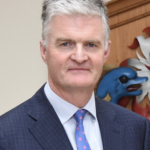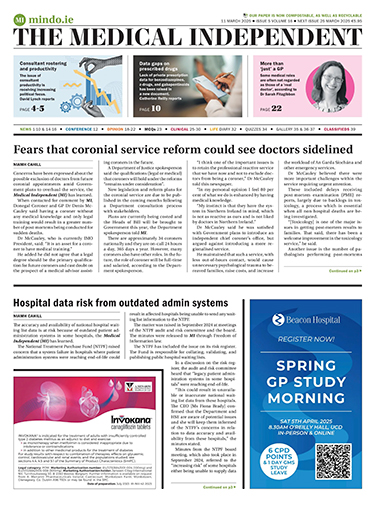Medical Director of HSE National Doctors Training and Planning, Prof Brian Kinirons, speaks to Catherine Reilly about a new project to find solutions to consultant recruitment difficulties in model 3 hospitals.

A service delivery “crisis” beckons if consultant posts in model 3 hospitals are not imminently made more attractive, according to Prof Brian Kinirons, Medical Director of HSE National Doctors Training and Planning (NDTP). Currently, around one-third of consultants in the model 3 hospital network are aged over 55 years. While consultant recruitment difficulties are widespread across the system, model 3 hospitals are facing particular challenges.
Prof Kinirons, a Consultant Anaesthesiologist, told the Medical Independent (MI): “If we don’t come up with solutions, we are going to have a service delivery crisis in a very short period of time. Because this workforce will retire, and if these sites are not seen to be attractive sites, then we are going to struggle.”
Project
The model 3 hospital network project, which is co-sponsored by NDTP and the RCSI, aims to provide methods to improve consultant recruitment to such sites.
The project, which began last year, has its origins in RCSI research published in 2017 in the Irish Journal of Medical Science (Mealy et al). It showed an impending surgical workforce crisis in model 3 hospitals, which deliver about 50 per cent of general surgical activity nationally. One-in-four consultant surgeons in model 3 hospitals were not in a permanent position, 54 per cent had not trained in Ireland, and 22 per cent were due to retire in the following five years.
“I was approached by the RCSI; [Consultant Orthopaedic Surgeon] Mr Paddy Kenny was really the instigator, in terms of whether NDTP would like to look at a broader context,” stated Prof Kinirons, who had felt the issues would be replicated in other specialties.
The data gathered and validated by NDTP has corroborated Prof Kinirons’ prediction.
Of the 807 consultants in the model 3 network, 7 per cent are in non-approved posts. This compares with 2 per cent in the model 4 network. Some 24 per cent of consultants in model 3 hospitals are not on permanent contracts, versus 12 per cent in model 4 hospitals. In addition, 7 per cent of consultants in model 3 hospitals are on the general division of the Medical Council register, compared with 1 per cent in model 4 hospitals.
The age profile of consultants in model 3 hospitals is also older.
“We know a third of all consultants in model 3 are over 55, versus 23 per cent in model 4. So this is an aging workforce. I guess in many ways the figures reflect a system that is under pressure. It reflects a fragile eco-system.”
Prof Kinirons acknowledged that some model 3 hospitals are even more “challenged” than suggested in the overall data
He added: “We have validated the data at a local site level; we have been in contact with every medical manpower manager within the network of all 18 hospitals and validated the data for their hospital.”
Prof Kinirons told MI the exercise was “not about saying ‘this hospital is good’ and ‘this hospital is bad’. It is about challenges, and certain hospitals are challenged, and the challenges may be geographic [and/or] could be related to certain specialties.”
The project team will be visiting a “significant portion” of model 3 hospitals to meet senior management, medical manpower managers, and consultants. These site visits are currently ongoing.
“We are trying to get a sense from the sites as to what the challenges are, in terms of thematic challenges, and there are themes emerging,” said Prof Kinirons, who indicated that national and local solutions would be required.
Themes
“I would also highlight the fact we are interrogating the future of the training community. We have an NCHD Lead in NDTP, Dr Caroline Herron, so we have put together a survey to ask our training community, the wider community, about their experiences in the model 3 networks in terms of education and training and what they would see as barriers to them taking up posts within this.”
Asked what themes have emerged on consultant recruitment, Prof Kinirons said: “Some of them are geographic. It is fairly clear that if your model 3 is located in proximity to model 4, many of the posts would have a split-site commitment and I think that makes posts potentially easier to recruit to.
“Again, if you look at sites that don’t have that, I think they would probably have bigger challenges in terms of recruiting to single sites. And one of the things that emerged from the surgical survey was the idea of being able to maintain academic interests and research interests and I guess the challenge of doing that is much easier when you have a model 4 piece to your contract as opposed to working [only] in a model 3….
“There are lots of other pieces to it,” he continued. “It is pretty clear that a lot of the colleagues in model 3s are working fairly onerous rotas, and if you have a choice between a non-onerous rota and an onerous rota, then it is fairly easy to see where the choices go. I think one of the challenges will be ensuring we have enough consultants to make the rotas sustainable and I think work/ life balance is going to be part of that.”
So if we can’t do something to incentivise recruitment, it will inevitably impact on patient care and patient safety
Prof Kinirons said “once we have all the pieces of that jigsaw, that will really inform the steering group that will then provide recommendations. Our ambition is that we would have a completed report by Q4 [2022] or at least Q1 of 2023 at the very latest. Our ambition would be that we would be able to pilot a site and implement some of the recommendations that will emerge from the NCHD survey, from the site visits, from the steering group direction… it is about implementation. The actual data doesn’t tell us anything we didn’t know already, and I suspect some of the pieces we get back from site visits will be what we know. So it is really about solutions and finding solutions.”
There are other parts of the world that have needed to find additional ways to boost medical recruitment – such as rural Canada and rural Australia, according to Prof Kinirons.
In some jurisdictions there has been assistance for doctors in finding accommodation and schooling for children, as examples. The international experience indicated that a “suite of interventions” tended to make a difference. Remuneration was an important factor, acknowledged Prof Kinirons.
On whether the recommendations would include issues around contracts, Prof Kinirons said: “The contracts themselves are national HR, they are not within the remit of NDTP, it is a completely different piece. And I am not presupposing what the recommendations will actually say, but… obviously there are Sláintecare contract negotiations, which are currently ongoing. So it is not about having a defined separate contract; it is about making these sites attractive to work in for lots of different reasons, be they professional, be they personal, be it work/life balance.”
Asked about the level of patient safety concern associated with this issue, Prof Kinirons said: “I would hesitate to say we are in a position where we have a patient safety challenge now, but I think we know that there are challenges where you cannot recruit to a particular site, to a particular specialty, and I think the CAMHS story reflects challenges around recruitment and patient safety. So if we can’t do something to incentivise recruitment, it will inevitably impact on patient care and patient safety, no question about that – I don’t think that is where we are right now.”
Prof Kinirons added that he had “no interest in just producing a report” for the sake of it.
“To me it is around implementation and making recommendations that we can actually see visible implementation on, and that is why I reference the potential to pilot a site within 2023, to see if we can make a difference.”
Prof Kinirons said the project steering group would decide upon the pilot site. He believed it would make sense to select one of the more “challenged” sites.
“In truth, unfortunately, there will be a choice of sites that are challenged within the model 3 network.”













Leave a Reply
You must be logged in to post a comment.